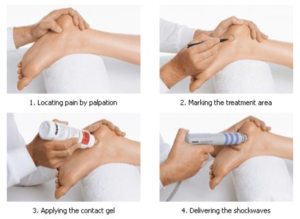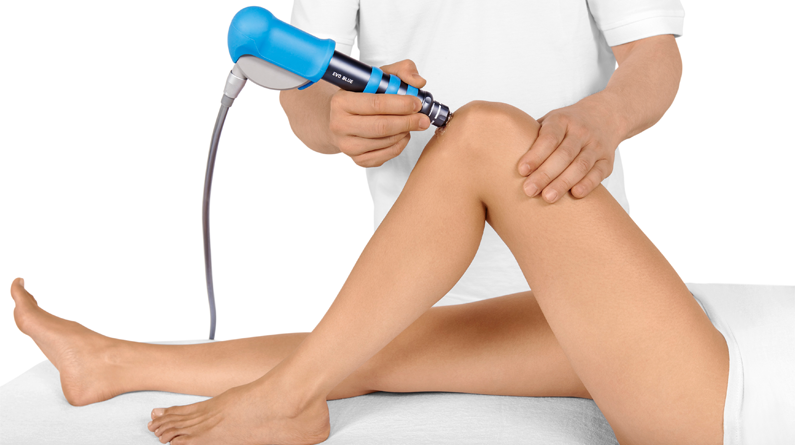Healing Foot Pain with Shockwave Therapy
Shockwave therapy (also known as Extracorporeal Shockwave Therapy or ESWT) is a modern technology that uses pulses of low-energy soundwaves to stimulate healing in muscles & tendons with chronic problems – as seen with chronic heel pain.
How is shockwave performed?
To send soundwaves through the desired muscles/tendons, ultrasound gel is placed over the affected areas, then shockwaves are transmitted from a rounded probe held against the skin and pulsed into the underlying tissues.

During treatment many patients report some tenderness, but normally no large amounts of discomfort are felt. Approximately 2000-3000 pulses/shocks are delivered per area and each treatment usually takes between 5 to 8 minutes.
Problems/pains can shockwave can help improve
The ability to loosen tight muscles and increase healthy, healing blood-flow to areas of the body can help improve many foot & ankle problems. Such as:
- heel pain / arch pain (ie. plantar fasciitis),
- Achilles or calf pain,
- ankle pains,
- lower leg pain,
- foot cramping

Treatment timing & intensity will be different based on where pain is focused, how long the problem has been present, and patient situation (eg. other treatments, work, sensitivity).
Many patients find pain relief for up to 10 days after the first treatment, and normally 3 to 5 treatments are required for complete repair/healing (with more or less treatments depending on each person’s needs). These treatments are delivered at weekly intervals.
What does shockwave actually do?
Shockwave works by stimulating the body’s natural self-healing process. By sending soundwaves in the form of repeated ‘shocks/pulses’ through the desired muscles/soft-tissue.
There are 4 main healing actions that occur after shockwave include:
1. producing a focused, healthy inflammatory response in weakened muscles or tendons, causing the body to increase metabolic activity around the sites needing it most.

2. gradual loosening of tight muscle ‘knots’/trigger points;
3. clearing of pain transmitters in the blood & affected areas (ie. Substance P, histamines and other nociceptive metabolites);
4. stimulating collagen production – these are the soft tissue layers needed before true repair of muscles, tendons & ligaments can begin.
Advantages & Disadvantages (vs. other treatments)
Like any treatment, shockwave has its strengths & considerations, especially when compared to other treatments such as cortisone injections, exercises, massage, dry needling, taping or orthotics.
However, it’s important to remember that many treatments (but not all) can be used together for greater effect – and it is rarely a “1 or the other” situation!
Key ADVANTAGES that make shockwave so exciting include:
- non-invasive technique (ie. nothing stuck to the skin, in your shoe, or in your muscles),
- minimal-to-no side effects,
- keep on walking – straight after treatment & the next day!
- fast pain relief (commonly).

You may need to AVOID Shockwave if you:
-
- are currently pregnant,
- are taking blood thinning medication / have blood clotting disorders,
- have a Pacemaker,
- have had recent a Corticosteroid injection (in the past 6 weeks) are under 18 (exception: can be used for Osgood Schlatter’s treatment under 18).
***for anyone described above: there are other treatments that will still be suitable with your podiatrist.
Most importantly…
While shockwave may hold the answer for your foot & ankle pains, everyone’s unique body and problems will often need different treatments to get things ‘just right’.
It is always best to check with your podiatrist as to which treatment is best suited – and if shockwave is the one for YOU!
Until next time, have fun and keep on walking!

